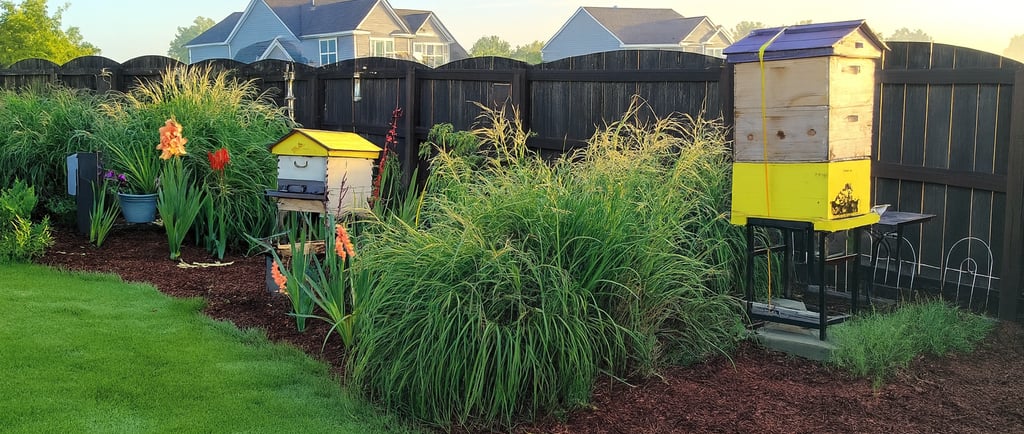time to prep your seedlings now!
The Beekeeper's Journal: The Sweet Sting of Trial and Error
Perspective of a Beekeeper
The Beekeeper
5/14/20253 min read


There’s a certain magic to beekeeping that you can’t quite understand until you’re suited up, smoke puffing gently from the smoker, and the low, harmonious hum of tens of thousands of bees vibrates through your gloves. People often see the end product—the beautiful jars of golden honey—and think it’s a serene, simple hobby. But any seasoned beekeeper will tell you: it’s a journey of constant learning, breathtaking highs, and frustrating, sticky lows.
My apiary isn’t huge—just a few hives tucked away on my property. But these wooden boxes have taught me more about patience and resilience than I ever thought possible.
Location, Location, Location
One of the first and most crucial lessons was hive placement. It seems straightforward, right? Find a sunny spot and set them down. My first error was placing them too close to a frequently used path. The bees, it turns out, have a well-defined flight path. Having them zoom past your head every time you take out the trash is… less than ideal.
I learned that they need morning sun to get them active, some afternoon shade in hotter climates to keep them from overheating, a windbreak, and a water source close by (so they don’t claim your neighbor’s swimming pool). Relocating the hives was a hassle, but it made a world of difference for both the bees' productivity and my peace of mind.
The Never-Ending Dance of Hive Maintenance
Hive inspections are where the real work happens. Every 7-10 days during the active season, you gently pry open the hive, frame by frame. You’re looking for the queen (a sigh of relief when you spot her), checking for eggs and brood patterns (a sign of a healthy, laying queen), and monitoring honey stores.
This is a classic area for trial and error. I’ve been overzealous and disturbed the bees too much, setting them back days. I’ve also been too timid and missed early signs of trouble, like a sneaky wax moth infestation or the first tell-tale queen cells that scream, "We’re about to swarm!"
Speaking of which…
The Heart-Stopping Swarm
Nothing prepares you for your first swarm. You look out your window and see a living, buzzing cloud the size of a beach ball swirling in your apple tree. Panic is the first instinct. I thought I had failed, that my colony was leaving for good.
But swarming is natural bee reproduction. The old queen takes half the workers to find a new home, leaving behind a new queen to carry on. It’s a sign of a strong, thriving colony, but it means a massive loss of honey production.
I’ve learned to manage it through techniques like splitting hives preemptively. But sometimes, despite your best efforts, they swarm. The "down" is the loss of bees. The "up"? Catching that swarm! There’s no greater thrill than gently clipping a branch, shaking thousands of bees into a new box, and giving them a fresh start. It’s beekeeping at its most primal and rewarding.
The Delicate Art of Requeening
Sometimes, a queen fails. She stops laying, or the colony becomes aggressive and unmanageable. This necessitates one of the most nerve-wracking procedures: introducing a new queen.
She arrives in a tiny, screened cage with a few attendant bees. You can’t just release her; the colony will see her as an intruder and kill her. The cage has a candy plug that the worker bees must slowly eat through over a few days. By the time they free her, her scent has permeated the hive, and she is accepted.
I’ve had this go perfectly. I’ve also had the workers reject her and ball her (a fatal mistake on my part in introducing her). It’s a humbling reminder that we are stewards, not commanders, of these complex little societies.
The Sweet Reward
After all the stings (yes, you get stung), the sweat, the worry over mites and predators, comes the harvest. Extracting honey is a sticky, glorious mess. The smell of warm wax and honey is intoxicating. Spinning the frames and watching that liquid gold pour out is a feeling of pure, unadulterated triumph. You taste honey that your bees made from the flowers in your very own environment. It’s a taste of place, of hard work, and of a successful partnership with nature.
For every jar of honey on my shelf, there’s a story of a mistake made and a lesson learned. The bees, in their infinite wisdom, keep teaching. I’m just here, listening and learning, one frame at a time.